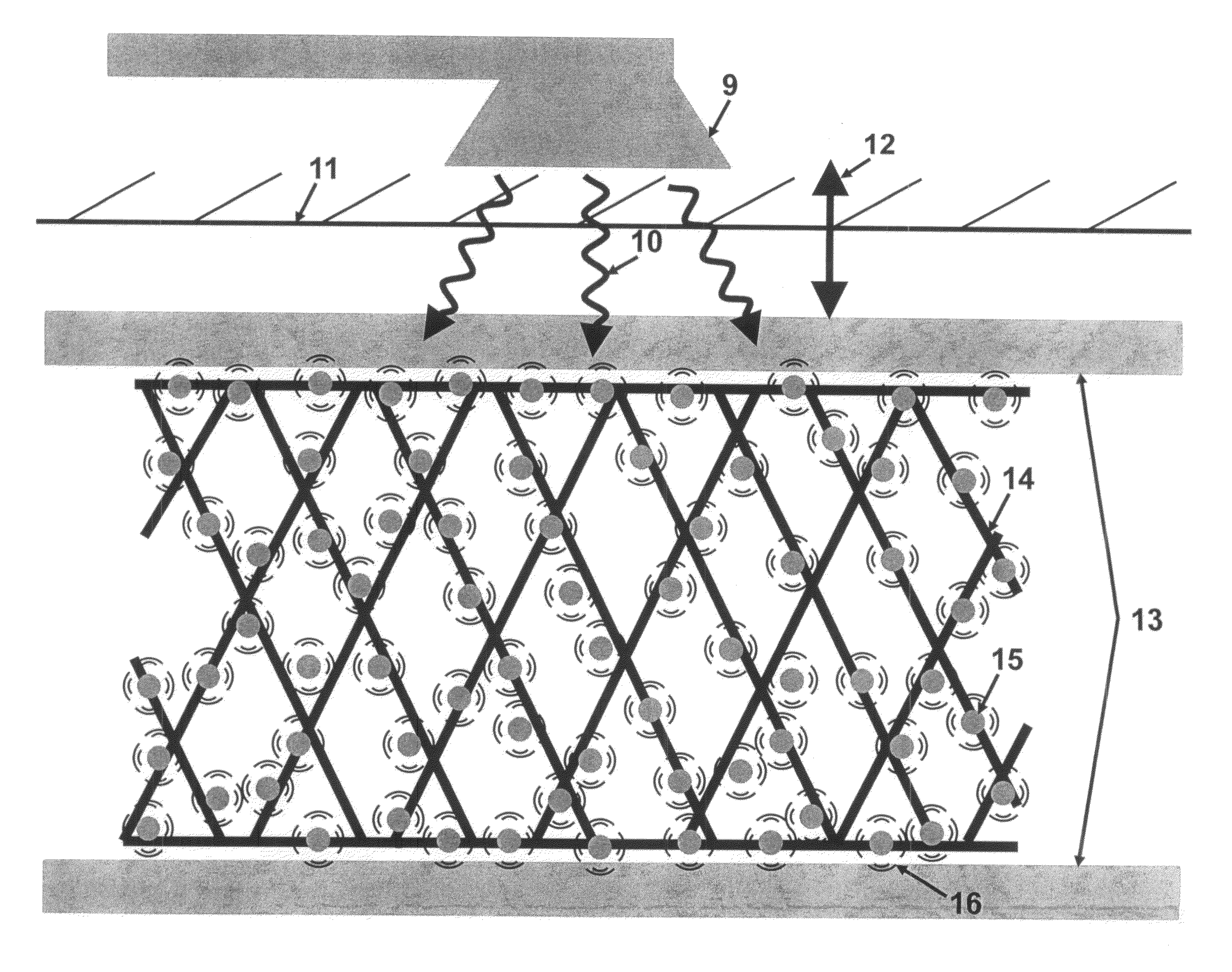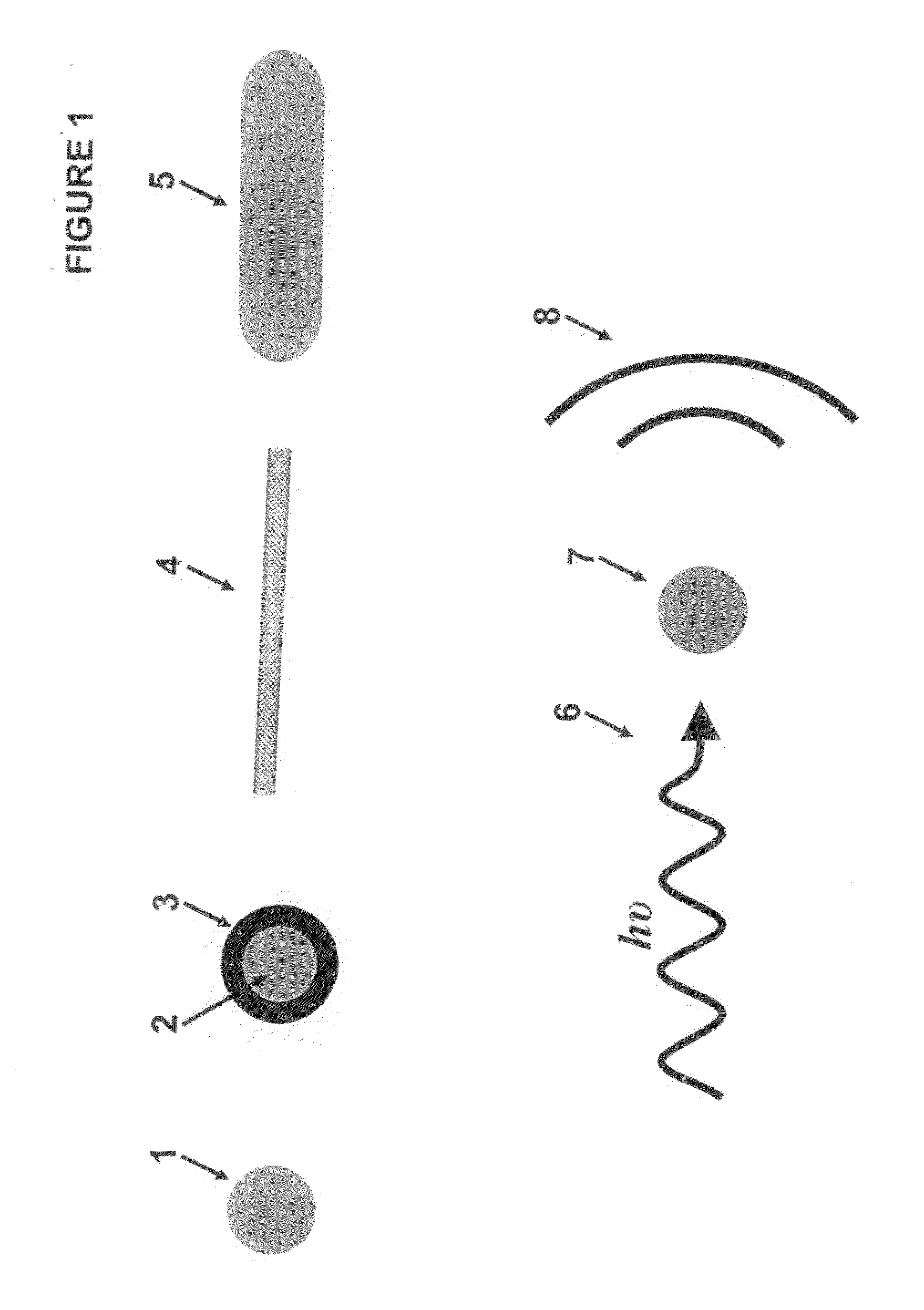All of these methods share the common deficiency of
poor control over the extent and intensity of the local tissue destruction because they are difficult to control, limit and focus, and cause collateral damage to surrounding tissue.
All previous clinical applications have had limited success in targeting and limiting the ablation energy, consequently, an ideal methodology should have the fewest long term negative effects.
Long term negative effects include excessive acute damage or negative chronic changes induced by excessive or insufficient energy.
Amongst these methods, the field of Plasmonic Photo
Thermal Therapy (PPTT) has gained ground due to its ability to achieve localized heating in the required temperature range, while being limited to a spatially confined region.
The methods described previously using nanoparticles for diagnostic treatment have been limited to
cancer treatment or
tissue repair, with the same physical properties of the PPTT used for the ablation of cells.
However, they failed to always prevent the intermediate (around 3 months) and long term consequence of new reactive
vascular tissue growth that would grow into the
stent lumen, leading to significant, and sometimes complete, narrowing or
occlusion.
The DES has successfully reduced or eliminated the problem of secondary tissue growth, but has done so with a cost.
The negative consequences of the DES approach are now becoming evident.
Since the
stent, usually a BMS, that forms the substrate for the chemical
surface coating of the DES, is a
foreign object, the uncovered
metal struts may adversely interact with blood components.
The DES induced scarred vessel surface, a direct result of over dosing the chemical ablation, cannot form the required properly functioning normal
epithelium because the vessel is too badly damaged to form
normal tissue, and thus forms scar.
It is the absence of this re-established normal
epithelium that typically beneficially prevents unwanted inflammatory occlusive in-growth into the lumen of the
stent, but comes with the
disadvantage of failing to prevent clot, i.e.,
thrombus, formation.
Consequently, the statistical morbidity and mortality benefits gained with use of DES, which prevents the slow secondary
occlusion of the vessel that is seen with the BMS, is countered in a DES with and equally potentially disastrous complication.
When a DES is the choice of stent, the benefit of reduced slow
occlusion is countered by the equally serious occurrence of statistically significant sudden
vessel occlusion that may follow a DES
insertion.
These techniques have the associated problems of ineffective control over the amplitude, duration, and extensiveness of the ablation, causing collateral damage to nearby tissue.
Furthermore, they typically can only be applied once, with additional procedures involving considerably more possible complications.
Long thought to be benign at best, or an “irritant” at worst, recent evidence suggests that these arrhythmias significantly shorten life and cause degraded
life quality.
Such arrhythmias also result in major health care costs and loss of economic productivity for those who would otherwise choose to work.
Both of these
physical limitations significantly limit the maneuverability of the
catheter, especially in small chambers such as the
left atrium, and particularly when there are numerous areas within that small chamber that must be precisely targeted.
However, focused and localized ablation to the precise origin of the arrhythmia failed, as the source site simply moved to a nearby undamaged area.
Such a technique is difficult since the
catheter is smaller than the circumference of the distal
pulmonary vein.
Significant manipulation coupled with
excess energy delivery was the solution, since precise manipulation of the catheter alone to treat the entire circumference without leaving open areas was nearly impossible and was therefore by itself insufficient.
Consequently, there were severe problems with these techniques.
Delivering energy to all of the tissue circumferentially often resulted in a miss of the targeted area, and therefore such technique is at best a “hit or miss” approach.
As a result, a “miss” could mean requiring a repeat procedure, with no guarantee that there would be a precise “hit” to the target area.
Importantly, each treatment caused significant scarring of the tissue forming the
pulmonary vein wall.
Because
scars contract, the scarring of the
pulmonary vein wall has been a significant problem.
Any contraction sufficient to
restrict or even occlude flow through the pulmonary
vein caused major complications, sometimes fatal.
Failure to stop the arrhythmia with a first treatment episode led to understandable extreme caution when considering a repeat procedure, which also was a problem in that the initial condition was not corrected.
This process is cumbersome,
time consuming and less than a completely successful method.
As before, failure to “close the circle” leads to a failure of the procedure itself.
With continuing further change this Dyslpastic tissue can become cancerous.
As discussed above, these methods have significant problems and inefficiencies, cause excessive tissue injury and subsequent scaring.
Unfortunately, the ablation methods are the known methods of
energy delivery, including RF, Heat, and Cryo cold techniques, as discussed above.
However, damaging bronchial tissue with
excessive energy and its
resultant scaring has been shown to sometimes significantly worsen these patients, and quite possibly fatally.
Still another problem for which ablation methods are used as treatment involves the sinus cavities, which communicate with the
airway passages via small orifices.
However, stents may close, and be difficult to replace.
Even if replaceable, there are significant limitations on the number of replacements possible.
While known ablation techniques may be employed, positioning can be difficult and can often lead to similar problems as discuss earlier.
Also, in women with diseases of the fallopian tubes, the passageways from the
ovary to the
uterus may have either
disease induced narrowing or may be congenitally narrowed leading to reduced
fertility or
infertility.
Likewise, women who have
tube closure for birth control, and who later wish to reverse this decision, may have difficulty keeping their fallopian tubes open after surgical reversal.
While such known ablation techniques may be employed, they can often lead to similar problems as discuss earlier.
Current techniques, by their nature can be utilized only for a very limited number of times, since the scarring that results from the extensive tissue destruction can lead to very serious outcomes.
As an example, targeted pulmonary veins, which are the conduits of blood entering the left heart from the lungs, may chronically scar after ablation and subsequently obstruct
blood flow into the heart, as a direct result of overly extensive
tissue damage secondary to currently applied ablation techniques used to treat
Atrial Fibrillation.
Excessive scarring here is catastrophic, potentially leading to complete obstruction of oral food passage from the
Esophagus into the
stomach.
 Login to View More
Login to View More 


